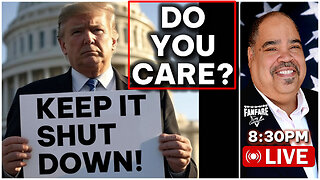Premium Only Content

Knowing when you are in a fight
I often see young leaders being attacked without even realising they are in a fight. Let me explain how you can spot this.
Topics:
- Office politics is a very messy business.
- At best, it’s a bunch of diverse people roughly pushing in the same direction, at worst they are actively working against each other.
- Many folks are two-faced and will be friendly to your face while nasty behind your back.
- This is classic passive-aggressive behaviour, which is defined as the following: “(of behaviour) characterized by indirect resistance to the demands of others and avoidance of direct confrontation.” (source: Oxford Dictionary)
- Essentially you are dealing with someone who does not like you, and is actively working against you behind your back, but they lack the courage to confront you directly.
- This personality type exists in large numbers in every organization, sadly.
- As a young professional, you may not be used to spotting such people however: you may even be fooled into believing they are your friends.
- But they are not.
- And the first step in winning a fight is to firstly know that you are in a fight.
- So, let’s look at some of the telltale signs of passive-aggressive behaviour:
1. The Disconnect Between Words and Actions A core element of passive aggression is when someone says they will do something, but their behaviour indicates the opposite. For example:
- Saying "Yes" but Acting "No": They might agree to a request enthusiastically, only to later "forget," procrastinate, or do the task poorly to show their resistance. For example, a teammate who agrees to do a task, but deliberately leaves it half done.
- "I'm Fine" Syndrome: When you can clearly see someone is upset, e.g. they are sullen, sighing, or giving you the silent treatment, but they insist that "nothing is wrong" or "I'm fine." This forces you to guess at the problem.
2. Covert Hostility and Indirect Insults Instead of direct confrontation, a passive-aggressive person uses subtle, underhanded ways to express their disapproval.
- Backhanded Compliments: A seemingly positive statement with a hidden insult. For example, "Your hair looks so much better now," which implies their previous hairstyle was bad.
- Sarcasm and "Joking": They may make critical or hurtful comments and then brush them off with "I was just kidding" to avoid being held accountable.
- Patronizing Language: Using phrases that undermine someone's intelligence or competence, like "Per my last email..." or "Do you understand what I'm saying?"
3. Resistance and Avoidance This behaviour often stems from an aversion to direct conflict.
- Procrastination: Deliberately delaying or failing to complete tasks as a way to express anger or resistance to demands.
- Chronic Lateness: Consistently arriving late to meetings, dates, or events to show a lack of respect or resentment without saying it.
- The Silent Treatment: Withdrawing from communication entirely to punish someone or avoid a difficult conversation. This leaves the other person feeling confused and powerless.
- Feigned Forgetfulness or Ignorance: Claiming to have "forgotten" an important deadline or a conversation to avoid responsibility.
4. Blaming and Victimhood A passive-aggressive individual may find it difficult to take responsibility for their own feelings or actions.
- Blame-Shifting: They may make excuses and blame others for their own failures. For example, "I would have done it, but no one reminded me." This is very common behaviour in my experience of dealing with such individuals!
- Complaining and Martyrdom: They might frequently complain about feeling underappreciated, overworked, or misunderstood, subtly positioning themselves as the victim to gain sympathy.
- The above list isn’t even exhaustive but hopefully gives you some clues to what to look out for, and you may have just realised that you are already encountering passive-aggressive individuals daily.
- With the exception of soldiers and martial artists, few people are comfortable with open conflict. The VAST majority of people are passive-aggressive, rather than outright aggressive.
- Passive-aggressive behaviour is often a coping mechanism for people who feel uncomfortable with or are afraid of direct confrontation.
- But as a leader it makes no difference to you: they are in conflict with you, therefore you need to confront them head-on and drag them into open conflict, where they are most uncomfortable.
- And you need to get comfortable with direct conflict. Studying martials arts helps.
- Smash them, and smash them hard. They are toxic to your team.
#leadership #tech #leader #team #management #manager #teamlead #techlead #software #conflict #resolution #passive #aggressive #behaviour #behavior #psychology
-
 1:04:10
1:04:10
The Connect: With Johnny Mitchell
3 days ago $14.43 earnedTucker Carlson's INSANE Take On Civil War In America, Calls For Fascism
30.7K89 -
 LIVE
LIVE
Lofi Girl
3 years agolofi hip hop radio 📚 - beats to relax/study to
162 watching -
 2:04:24
2:04:24
FreshandFit
11 hours agoGianni Blu Meets 305
188K10 -
 2:37:35
2:37:35
Badlands Media
12 hours agoDEFCON ZERQ Ep. 014: Marker Nine – The Ninth War Is Coming
64.8K68 -
 2:10:43
2:10:43
Inverted World Live
8 hours agoTop General Outsourcing Decisions to ChatGPT | Ep. 127
80.4K9 -
 2:46:27
2:46:27
Laura Loomer
8 hours agoEP151: Democrats Meet With Terror Tied Islamic Group During Government Shutdown
24.4K16 -
 3:02:06
3:02:06
TimcastIRL
7 hours agoPortland Police PROTECT Antifa From DHS Arrest, Trump Admin Says SEND IN THE GUARD | Timcast IRL
220K128 -
 2:49:50
2:49:50
Barry Cunningham
7 hours agoPRESIDENT TRUMP SPEAKS TO THE PRESS...NO DEALS! DO YOU CARE IF THE GOVERNMENT STAYS SHUT DOWN?
42K41 -
 1:37:24
1:37:24
Tundra Tactical
5 hours ago $12.74 earned🚨🚨Emergency Gun News!!!!🚨🚨 Did Glock Just Cave To Liberal Pressure?? Current Glocks Done?
28.4K4 -
 1:02:57
1:02:57
Sarah Westall
8 hours agoStructure of the World has Changed and Getting Back to Basics w/ Stacy Washington
44.9K10